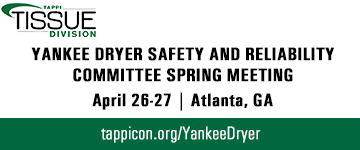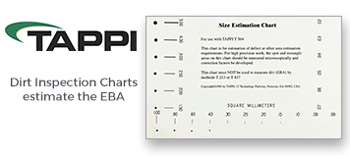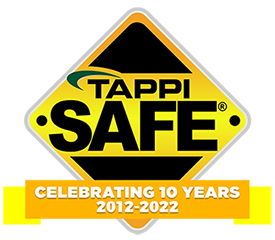 Search
Search
Use the search bar or filters below to find any TAPPI product or publication.
Filters
Content Type
Publications
Level of Knowledge
Committees
Collections
Journal articles

Magazine articles

Techno-economic analysis of hydrothermal carbonization of pulp mill biosludge, TAPPI Journal March 2023
ABSTRACT: For many mills, the biosludge from wastewater treatment is difficult to recycle or dispose of. This makes it a challenging side stream and an important issue for chemical pulping. It often ends up being burned in the recovery or biomass boiler, although the moisture and non-process element (NPE) contents make it a problematic fuel. Biosludge has proven resistant to attempts to reduce its moisture. When incinerated in the biomass boiler, the heat from dry matter combustion is often insufficient to yield positive net heat. Mixing the sludge with black liquor in the evaporator plant for incineration in the recovery boiler is more energy efficient, but is still an additional load on the evaporator plant, as well as introducing NPEs to the liquor. In this study, treating the biosludge by hydrother-mal carbonization (HTC), a mild thermochemical conversion technology, is investigated. The HTC process has some notable advantages for biosludge treatment; taking place in water, it is well suited for sludge, and the hydrochar product is much easier to dewater than untreated sludge. In this study, two HTC plant designs are simulated using IPSEpro process simulation software, followed by economic analysis. Low temperature levels are used to minimize investment costs and steam consumption. The results show that if the sludge is incinerated in a biomass boiler, payback periods could be short at likely electricity prices. The HTC treatment before mixing the sludge with black liquor in the evaporator plant is profitable only if the freed evaporator capacity can be used to increase the firing liquor dry solids content.
Journal articles

Magazine articles

Research on flame-retardant paper prepared by the method of in-pulp addition of ammonium polyphosphate, TAPPI Journal May 2023
ABSTRACT: At present, the production of flame-retardant paper usually uses the impregnation method of phosphorus-nitrogen flame retardants in paper. There are few reports on the application of an in-pulp addition method. In this paper, the solubility of ammonium polyphosphate (APP) and its effect on flame-retardant paper were investigated for use in an in-pulp addition method. It was found that APP particles were square, with an average particle size of 21.88 µm. The particle size decreased significantly after immersion in water at 25°C for 24 h. Furthermore, most of the APPs were dissolved after immersion in water at 90°C for 0.5 h, and the residuals agglomerated and their shape turned into an amorphous form. The APP possessed strong electronegativity and could partially ionize in water. The solubility of APP was 0.18 g/100 mL water at 25°C and increased quickly when the temperature was higher than 30°C. Therefore, APP should be added to the pulp at temperatures below 30°C. The tensile strength of the paper initially increased with the addition of APP, and it reached the maximum value when the APP content was 10% and then gradually decreased. The limiting oxygen index (LOI) value of the paper was 28.7% when the added amount of APP was 30% and cationic polyacrylamide (CPAM) was 0.08%, reaching the flame-retardant level.
Journal articles

Magazine articles

Using bleaching stage models for benchmarking softwood ECF bleach plants, TAPPI Journal July 2022
ABSTRACT: Steady-state bleaching delignification and brightening models were used to gauge how well elemental chlorine-free (ECF) bleach plants were using chlorine dioxide to bleach 25-kappa softwood brownstocks. Case 1 examined the D0(EOP)D1 portion of Mill 1’s five-stage sequence that brightens the pulp to 86% ISO. Case 2 studied the D0(EO)D1 portion of Mill 2’s four-stage sequence, which brightens the pulp to 82% ISO, and Case 3 re-examined the same bleach plant several years after it made improvements around the extraction stage. The models highlighted days in the previously mentioned cases where high bleach usage occurred, presumably because of high brownstock and/or extraction washer carryover, and days where bleach usage was normal. In Case 2, the model esti-mated that 10 kg of the 44 kg chlorine dioxide/metric ton pulp consumed in bleaching was likely reacting with washer carryover sources; approximately two-thirds of this extra consumption was assumed to be reacting with extraction filtrate. Changes that Mill 2 made (Case 3) reduced the unproductive chlorine dioxide usage from 10 to 5 kg/metric ton pulp. When the delignification and brightening models were simultaneously solved, the models predicted somewhat different optimized distributions of chlorine dioxide to D0 and D1 vs. actual values used in bleach plants. However, the forecasted chlorine dioxide totals agreed with the actual values when washer carryover sources were considered. This study showed the bleaching models could be used as hypothetical benchmarks for softwood ECF bleach plants.
Journal articles

Magazine articles

Water chemistry challenges in pulping and papermaking • fundamentals and practical insights: Part 1: Water chemistry fundamentals and pH, TAPPI Journal June 2022
ABSTRACT: Water is an essential component of the papermaking process. Nevertheless, papermakers often overlook its importance compared to fibers and chemical additives. A better understanding of water properties and chemical interactions associated with water at the wet end leads to a sound foundation for high-quality paper production and smooth operation. Not all fresh water and process water is the same. Fresh water varies from mill to mill, primarily due to the location and availability of water sources. Some industrial trends, such as enhancing water conservation and production yield, gradually shift process water quality over time. The current work serves as a primer on water and water chemistry fundamentals to help the papermaker prepare for the future challenges of increased contamination of process water associated with reduced fresh water usage. This paper focuses on basic water chemistry definitions and discusses the impact of pH on wet-end operation. It is clear that pH is a fundamental factor that directly affects the process and impacts other factors relevant to the papermaking process. It is crucial to understand what pH represents, how it is measured, how to select the proper pH and carefully control it, and how to closely maintain the process at target setpoints. Understanding the sensitivity of operation to pH change will lead to an appropriate focus on these issues. In addition to basic theory, we also review onsite experience and practical mill cases. It is imperative to stress that, although critical, pH is not the only chemical parameter impacting papermaking operations. Other factors, such as ionic concentration measured by conductivity, surface, soluble charge, and hardness, are critical and will be discussed in Part II of this series. As pH is a primary and independent factor that impacts various forms of charge and conductivity, the authors decided to start the current series of papers by discussing pH.
Journal articles

Magazine articles

Three-dimensional visualization and characterization of paper machine felts and their relationship to their properties and dewatering performance, TAPPI Journal July 2021
ABSTRACT: Polymeric felts are commonly used in the papermaking process on the paper machine wet end, in the press section, and in the dryer section. They provide an important function during paper manufacturing, including as a carrier or support; as a filter media assisting with water removal on the paper machine; in retention of fibers, fines, and fillers; and in some applications, such as tissue and towel, to impart key structural features to the web. These felts can have highly interwoven complex internal structures comprised of machine direction and cross-machine direction yarns of varying sizes and chemical compositions. Here, we present a non-intrusive three-dimensional (3D) image visualization method using advanced X-ray computed tomography (XRCT). This method was used to characterize the complex 3D felt structure and determine the water removal characteristics of some commonly used paper machine felts. The structural features analyzed include porosity; specific pore-yarn interfacial surface area; 3D pore size distribution; 3D fiber or yarn-size distribution; and their variations through the thickness direction. The top, middle, and bottom layers of the felt have very different structures to assist with water removal and impart paper properties. The size distribution of the yarns, as well as the pores in the different layers of the felt, are also inherently different. These structural features were non-intrusively quantified. In addition, variation in the structural characteristics through the thickness of the felts and its potential role in papermaking is explored. In addition to the 3D structural characteristics, permeability characteristics and water removal characteristics, including rewetting of select felt samples, have also been experimentally determined. It is interesting to observe the relationship between key structural features and permeability and water removal characteristics. These relationships can provide additional insights into press felt design, as well as ways to improve product properties and the dewatering efficiency and productivity of the paper machine.
Journal articles

Magazine articles

Functionalization of wood/plant-based natural celluslose fibers with nanomaterials: a review, TAPPI JOURNAL February 2018
Functionalization of wood/plant-based natural celluslose fibers with nanomaterials: a review, TAPPI JOURNAL February 2018
Journal articles

Magazine articles

Print quality of flexographic printed paperboard related to coating composition and structure, TAPPI Journal January 2018
Print quality of flexographic printed paperboard related to coating composition and structure, TAPPI Journal January 2018
Journal articles

Magazine articles

Understanding the pulping and bleaching performances of eucalyptus woods affected by physiological disturbance, TAPPI Journal November 2018
Understanding the pulping and bleaching performances of eucalyptus woods affected by physiological disturbance, TAPPI Journal November 2018
Journal articles

Magazine articles

Regulatory and sustainability initiatives lead to improved polyaminopolyamide-epichlorohydrin (PAE) wet-strength resins and paper products, TAPPI JOURNAL September 2018
Regulatory and sustainability initiatives lead to improved polyaminopolyamide-epichlorohydrin (PAE) wet-strength resins and paper products, TAPPI JOURNAL September 2018
Journal articles

Magazine articles

Cracking at the fold in double layer coated paper: the influence of latex and starch composition, TAPPI Journal February 2019
Cracking at the fold in double layer coated paper: the influence of latex and starch composition, TAPPI Journal February 2019





